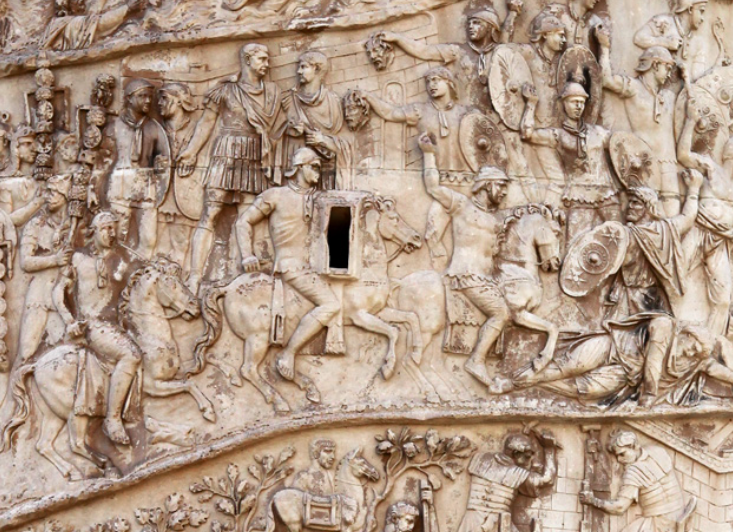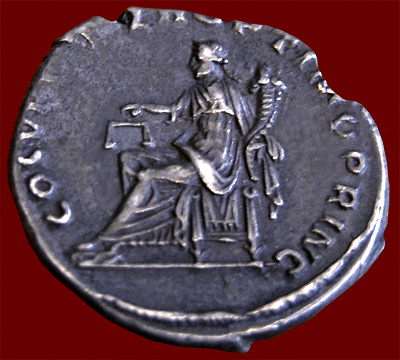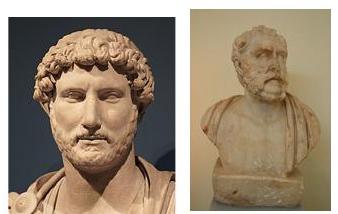
I have been posting preliminary information on dates that are widely assigned to the Book of Revelation but have decided to jump ahead and make it clear where these posts are headed.
Thomas Witulski has presented some interesting arguments for dating Revelation to the time of the lead up to and beginning of the Bar Kochba war in the time of Emperor Hadrian, between 132 and 135 CE.
So how does that setting fit with the “four horsemen of the apocalypse”?
- The white horse is the conquering emperor Trajan. White horses in mythology and historical triumphs were associated with conquerors in their triumphs (and with Zeus himself).
- The red horse represents the various messianic-led Jewish uprisings in the years leading up to the 130s throughout Cyrenaica, Egypt, Cyprus and Mesopotamia.
 The black horse whose rider carries the scales represents a ruler responsible for justice (as commonly symbolized at that time by scales, emblem of the goddess Aequitas); prices are said to be extremely high but, contrary to a famine setting, land producing oil and wine was not to be touched and converted to grain production. This horse represents a governor of Asia who was forced to cope in condign ways with the results of the Jewish revolts that had reduced grain supplies from Egypt.
The black horse whose rider carries the scales represents a ruler responsible for justice (as commonly symbolized at that time by scales, emblem of the goddess Aequitas); prices are said to be extremely high but, contrary to a famine setting, land producing oil and wine was not to be touched and converted to grain production. This horse represents a governor of Asia who was forced to cope in condign ways with the results of the Jewish revolts that had reduced grain supplies from Egypt.- The pale horse represents the fate of the Jews following the suppression of their uprisings — death, executions, famine, wolves threatening survivors in areas reduced to chaos.
Okay, so what about the measuring of the temple?
The rebels’ programme of (re)building the Yahweh sanctuary in Jerusalem and reinstalling the priestly-dominated cult of the temple should also be understood in this context: (a) The measuring out described in Apk 11:1-2a for the purpose of rebuilding or reestablishing the temple, the θυσιαστήριον and the worshippers there presupposes that these buildings and conditions are not present or destroyed at the time of the writing of the Apk. This obviously corresponds exactly to the conditions in Jerusalem at the threshold of the Bar-Kokhba revolt, as Cassius Dio describes them2, (b) The depiction in Apk 11:1-2a. according to which the apocalyptic was commissioned to measure the temple, the θυσιαστήριον and the people worshipping there for the purpose of new construction or rebuilding, but did not (or could no longer) carry out this commission3, ties in with the corresponding programme described above. At the same time, however, it also reflects the apocalypticist’s assessment of the further course of the rebellion, which he had to arrive at after taking into account the various measures taken by the Romans to put down the uprising5: The rebels did indeed consider Jerusalem and the sanctuary of Yahweh. Jerusalem and the Yahweh sanctuary and to reinstall the temple cult; in the end, however, the ναός τοΰ θεού and the associated θυσιαστήριον – at least according to the apocalypticist’s assessment – will not be rebuilt, for those who want to worship there and practise the Jewish worship of God, there will not be such a possibility (anymore).
The historical reference of Apk 11:1-2a to the first phase of the Bar Kokhba revolt becomes even more conclusive if it is assumed that the decision to (re)found Jerusalem as the Roman colony of Aelia Capitolina and, in connection with this, the decision to erect a pagan sanctuary there can be dated to the time immediately before the military escalation, i.e. around 130 AD. Then the statements of Apk 11:1-2a could be referred to these decisions of Hadrian without any problems: The apocalypticist is supposed to measure the temple, the θυσιοοτήριον and the people worshipping there for the purpose of rebuilding or reconstruction.
(Die vier apokalyptischen Reiter, pp 305f; translated)
The two witnesses?
Bar Kochba and the priest Eleazar, the political and religious leaders of Israel who were dedicated to the liberation of Judea from the Romans. I know. Questions arise. I will address details in future posts.
The beast and his false prophet?
Hadrian and his advisor, propagandist and rhetor Antonius Polemon.
The author expected Hadrian to kill the Bar Kochba and the priest Eleazar and that the whole world would rejoice in the destruction of those it held responsible for war.
The posts won’t be completed this week, but hopefully they will be finished before year’s end.
.
Witulski, Thomas. Apk 11 und der Bar Kokhba-Aufstand : eine zeitgeschichtliche Interpretation. Tübingen : Mohr Siebeck, 2012, http://archive.org/details/apk11undderbarko0000witu.
—. Die Johannesoffenbarung Und Kaiser Hadrian: Studien Zur Datierung Der Neutestamentlichen Apokalypse. Vandenhoeck & Ruprecht, 2007, http://www.librarything.com/work/5467644/book/208189148.
—. Die vier apokalyptischen Reiter Apk 6,1-8: Ein Versuch ihrer zeitgeschichtlichen (Neu-)Interpretation. Vandenhoeck & Ruprecht, 2015.
If you enjoyed this post, please consider donating to Vridar. Thanks!


Considering the Number of the Beast has long been linked to a numerical representation of the name Caesar Nero, that seems to be the better correlation. Assuming Nero is the Beast and that the other two figures are based on historical personas as well, the Whore of Babylon in most verses is a symbol of Rome itself but could also be a refernce to Nero’s mother given the rumors that surrounded them, and the False Prophet may well have been Seneca, many of whose Stoic sayings can be paralleled with those of the Cynic sayings of Jesus. Another prophecy said that a second Beast would come who had horns like a Lamb but spoke like a Dragon would come and force everyone to worship the risen image of the first Beast, which makes one think that they would imagine someone like Seneca, who portrayed himself as an anti-elite Stoic while at the same time supporting the emperor (13:11). As for the Four Riders of the Apocalypse, the first was given a crown, which sounds like Simon ben Giora, who was given control of Jerusalem by the authorities and who was captured in kingly attire and paraded in Rome in it. The second rider is given a sword and that fits John of Giscala who had the Zealots take over Jerusalem. The third rider says “Do not damage the oil and wine”, which must be Eleazar ben Simon because it was John of Giscala who used up the sacred oil and wine after taking control of the Temple from Eleazar ben Simon (Wars 5.13.6). The fourth rider is called Death, but he might also represent Titus and the Fall of Jerusalem. The story of John being a prisoner on Patmos may reflect a tradition that the book was written by John of Giscala, who was himself taken prisoner after the war.
I’ll be demonstrating that the Hadrian thesis fits many more details in Revelation than any other interpretations I have read. I only skimmed the surface in the above post.
Seneca had some connection to Paul. His brother Lucius Junius Gallio Annaeanus was after all the Roman official who saved his hide in Corinth. There was a trial lawyer in St. Louis about a decade back who wrote something suggesting a Herodian Paul could of been sent off to Rome at age nine or ten to be brought up with and educated alongside all sorts of other noble youths from the peripheral client kingdoms. Just the sort of places Seneca spent periods of his life teaching those who would someday hold power.
Alternatively, those who wrote the letters in the name of Paul knew Seneca’s writings and were influenced by them.
As for the “beast” connection, my recollection is that Seneca lost influence over Nero when Nero came of age. I don’t know of any reason to think of Seneca as an advocate for Nero as emperor.
No, Seneca was Nero’s advisor for 5 years until he was implicated in a plot to kill him and forced to commit suicide with Stoic calm. Nero is specifically called “the Beast” by Apollonius of Tyre, who has a pretty strong connection to the “former priest of Apollo”, Montanus, a figure I believe is also known by “Apollos” in Acts, as Montanus/Apollos had a duet disciples prophets in which one is named Priscilla (Acts 18:26). Montanus is likewise not a real name but just a decription of the “mountainous” area of Phrygia. Apollonius is also an alternative reading of Apollos in 1 Cor. 3:6. The story of Jesus slaying the Dragon shortly after born is also aa carbon copy of the myth of Apollo and his motehr Leto, down to the “woman clothed in the sun and the moon under her feet” being a reference to Apollo’s mother, the sun/moon goddess Leto (so our version of Revelation is second century Hellenist background, but my former interpretations of the Four Riders shows a more first century Jewish focus.)
A specific Christian obsession with Nero is substantiated in the Ascension of Isaiah 4:1-14 and Sibylline Oracles 4:119-124; 5:137-154, 361-374. There are seven kings of Roman, the sixth being present (Nero), while the seventh king, Galba, is said to be there only a little while as he died after a few months. The eighth king who rises from the pit is said to be one of the seven, an obvious association with the legend of Nero’s resurrection, which was so popular that there were at least three men who claimed to be Nero reborn.
The first Roman-Jewish War, essentailly started by Nero, was heavily associated with Galilean rebels, which better much fits the Jewish Christian milleau of the time, but given that Bar Kokhba was a Pharisee who identified himself as the Messiah, it probably would have borne mixed results with the increasingly Hellenistic Christians by the second century. The canonical version of Mark seems to have been sympathetic as he has Simon “of Cyrene” (where the Second Roman-Jewish War started), who like Simon bar Kokhba had a son named Rufus, carrying Jesus’ cross. But the Gospel of Basilides shows Jesus laughing at Simon of Cyrene being crucified in his place, which would be monstrous if Simon of Cyrene was just some innocent bystander, but makes complete sense if the Gnostic Gospel was seeking to mock the idea that Bar Kokhba was killed by the Romans for falsely identifying himself as the Messiah.
However, I do think Polemon of Smyrna does have a Christian association elsewhere: he is probably the inspiration behind Polycarp of Smyrna, a Sophist who lived around the same time but was far more popular. Eusebius even brings up a third figure from the same area, Polycrates, who is probably just another invented person inspired by Polemon.
Ah, you’ve compelled me to dig out my old copy of Tacitus. I was misremembering a particular passage where Seneca’s opponents were advising Nero to get rid of Seneca from his circle because he, Nero, was “now of age” or an adult and no longer in need of his tutoring. Nero, of course, was in his early twenties at that time.
The first years of Nero’s reign have gone down well in historical memory, as you no doubt know, but my understanding is that that is said to have been the result of the influence of Nero’s two advisors, Seneca and Burrus. From the time Burrus died Seneca also lost his influence over Nero. I don’t know if there is any reason to think of Seneca as some sort of “prophet” who propagandized and was exceptional in advocating for people to submit reverentially to Nero.
As for Nero being the reputed “beast” and identified with 666 in Christian circles, I am not denying at all. Rather, that very point is critical to Witulski’s discussion of how Hadrian came to be identified as “Nero redivivus”.
I’m glad you raised that detail. I was saving it for another post but I’ll spill it out here.
Hadrian’s name in its Hebrew form also equals 666; for several reasons Hadrian presented as the Nero redivivus that so many had long anticipated.
(The alternative spellings of the name = 616)